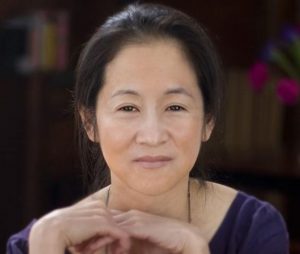Julie Otsuka publishes one novel every decade. Her first novel, When the Emperor Was Divine, was published in 2002 and her second, The Buddha in the Attic, in 2011; the most recent, The Swimmers, graced the world in March 2022. I read all three of her novels over the course of a week this past July, a fact that may sound impressive but is actually not, considering that none of these novels exceeds two hundred pages. The physical design of these books (all published by Alfred A. Knopf) emphasizes their relative tininess: they all have nearly-square covers, and are compact enough to fit into an average-sized pocket in an article of men’s clothing or a large-sized pocket in an article of women’s clothing. In spite of its stature, however, Otsuka’s oeuvre reveals that she can be a master of style and form, and even when she is not, she remains an unconventional, experimental novelist.
When the Emperor Was Divine follows the internment of a Japanese-American family during World War II; the novel is split into five chapters, each from a different perspective. In American classrooms, it is often taught alongside the 1973 memoir Farewell to Manzanar, which recounts a young girl’s experience in an internment camp. Otsuka’s undergraduate training in painting shines through in her prose. She is an unapologetically beautiful writer even in her debut. Her second novel, The Buddha in the Attic, goes a step further in its exploration of the history of Japanese-Americans. It focuses on Japanese picture brides, or women who arrived in America to be wed to male immigrant workers based almost exclusively on an exchange of photos. In this way, The Buddha in the Attic sheds light on a chapter of Japanese-American history less familiar to the typical reader than that of internment.
The true victory of The Buddha in the Attic, however, lies in its narration. The novel is told through the “we” pronoun, which ostensibly refers to the picture brides, but it simultaneously refuses to generalize their lives into an undifferentiated mass: “Some of us were from a small mountain hamlet in Yamanashi and had only recently seen our first train. Some of us were from Tokyo, and had seen everything, and spoke beautiful Japanese, and did not mix much with any of the others. Many more of us were from Kagoshima and spoke in a thick Southern dialect that those of us from Tokyo pretended we could not understand.” The collective narration does not preclude the differences in the women’s lives; rather, the cognitive exercise that the novel asks its readers to undertake is that of understanding the richness of each individual’s life within the broader scope of a shared experience.

The ethnographic-adjacent nature of the book, then, poses immense questions: how different can a life be from another life? How similar can they be? How do the external, unchangeable parameters of one’s life determine the shape it takes? (The novel follows the women from the ship that brings them from Japan to America until their internment during World War II, and in a fascinating twist at the end, the “we” of the last chapter changes). Deservingly, The Buddha in the Attic was nominated for the National Book Award for Fiction and won the PEN/Faulkner Award for Fiction in the year of its publication.
Otsuka’s latest book, The Swimmers, attempts to combine the collectivist approach of her second novel with the single-family focus of her first, to varying degrees of success. To its credit, it has a more creative premise than the other two: a group of swimmers in a California community notices a crack at the bottom of their pool, which throws them into a disarray. One of these swimmers is Alice, an aging Japanese-American woman whose memory loss gradually takes over her life. The first few chapters of the novel are narrated from the perspective of the swimmers; Alice’s daughter gets a chapter, as does the assisted living company into which Alice is eventually placed.
These shifts in narration sound interesting, but they create a sense of unease in the reading experience; unlike with The Buddha in the Attic, the reader doesn’t know where they are heading. This might make sense for a novel thematically concerned with suspense and sudden change, but The Swimmers is not such a novel. Politically, however, the novel is far more unorthodox than its predecessors. There is a slight reference to internment, but Otsuka neither dwells on it nor uses it as an eerie tool of foreshadowing; rather, the novel directs its sharpest ethical critique towards the institution of for-profit “care” for those with illnesses (certainly a potent target, especially given the COVID-19 pandemic). The Swimmers, then, breaks from the categorization of “ethnic” fiction that the earlier two novels could be slotted into, but still refuses to ignore the historical reality of its characters.
Will we have to wait another ten years for a Julie Otsuka novel? Likely the answer is yes. We don’t know if Otsuka actually spends ten years writing these novels. Either way, the time in between publication of her novels forces us, the readers, to contend with the unequal expenditure of effort for reader and writer in the mutual act of creating meaning in a text, a disparity not addressed often enough. I may have read her body of work in a week, but it deserves more attention than I’ve given it so far, especially given her consistent desire to innovate within fiction.
*









I am very thrilled to see an article on these novels. My love with Japanese Literature started about 12 years ago with Julie Otsuka and Yoko Ogawa. Ever since reading these gems I am hooked to Japanese literature. These are beautifully crafter heart touching stories, with way less words needed usually needed to narrate. What a craft!! Thanks for the article. I have yet to read ‘The Swimmers’.
This is an interesting introduction to
Julie Otsuka’s writings. Thankyou.